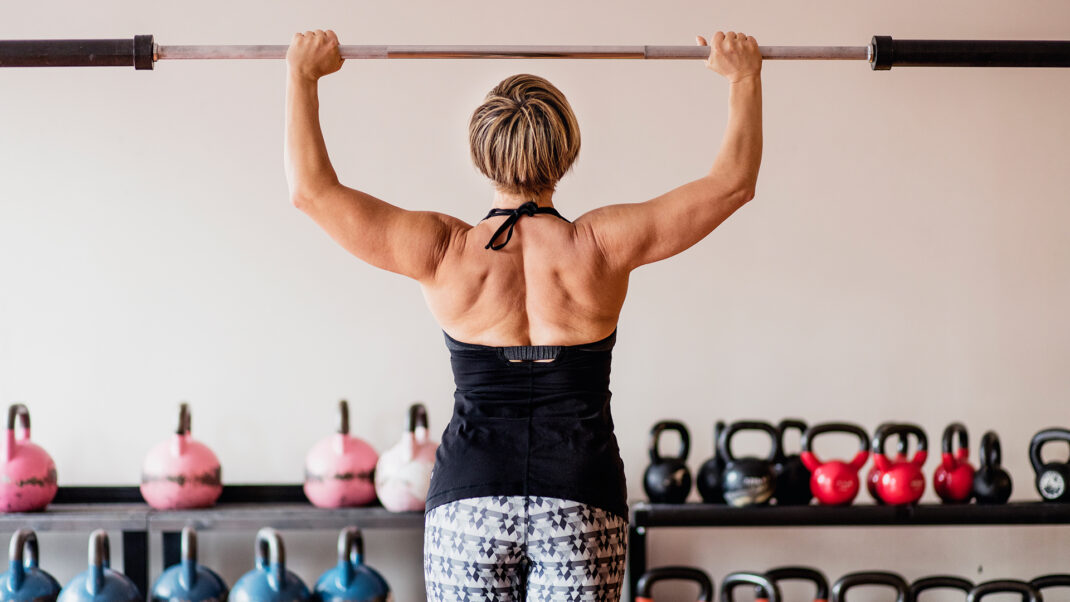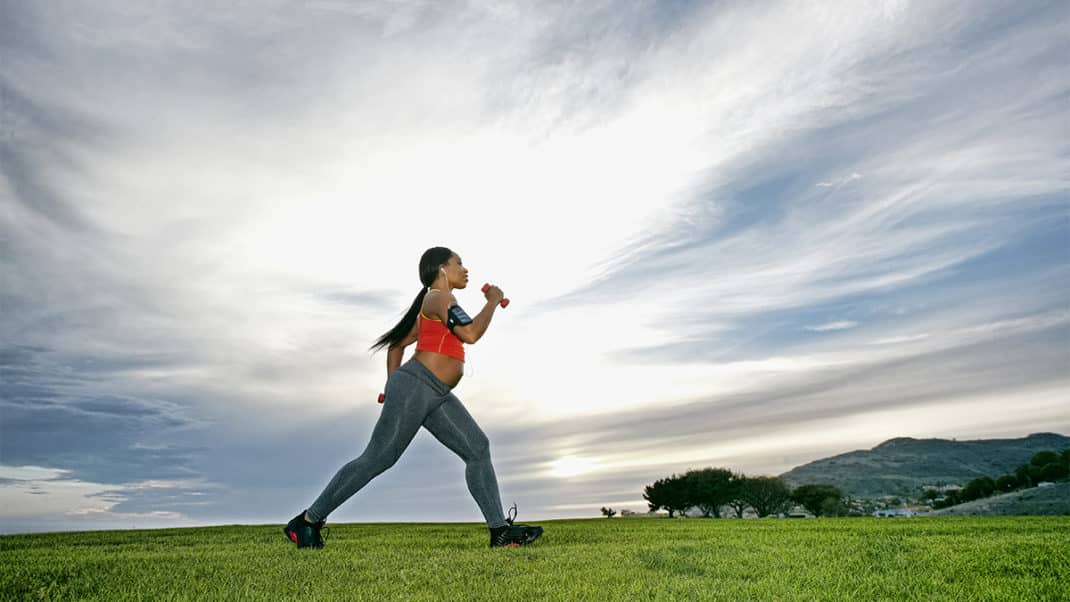Women on Weights
Teach a progressive strength class.
Strength training is finally getting the attention it deserves as a beneficial, safe and effective exercise for women. After years of misinformation, women are learning that strength training not only enhances muscle tone but also boosts metabolism, augments fat oxidation and reduces injury risk. Fitness instructors can make the most of this newfound awareness by offering a well-designed strength class that includes a variety of equipment, targets multiple muscle groups and emphasizes function.
I have created a program I call “Women on Weights,” a 6-week course that features 12 workouts and the following training priorities:
- varied training principles (single/super-set and combination training for efficiency)
- training of moderate to high intensity (only after foundational strength has been achieved)
- cross training
- a focus on core, hip and shoulder stability training
Although the program introduces a new muscle group each week, the entire body is always trained. Class size should remain relatively small (six to 12 people) so that you can address special needs and accommodate different goals. Music is optional, but if you use it, choose a tempo that will not distract from the exercises.
The following design is broken down
by muscle group and details the proper progression over a 6-week period (see chart for more details). The program’s focus is to establish a foundation of strength and build endurance. All classes last at least 45 minutes and include a warm-up (7 to 10 minutes), a training session (30 minutes) and a cool-down
(5 to 7 minutes). Each participant
requires a step platform with four risers, one or two sets of dumbbells (2 to 5 pounds) or a weighted bar (10 to 15 pounds), a resistance tube and a mat. The program trains large to small
muscle groups and integrates the upper body throughout for time efficiency.
“Three-Legged” Squat. Squat on the spot (OTS) with arms lifted in front, using barbell to balance. Options: Lift weight or place towel/water bottle
between knees.
Wide Squat. Straddle bench width-wise with arms raised in front. As you lift arms, squeeze bench (grip it with lower legs, recruiting inner thighs) so that you can squat deeper.
Single-Leg Dip Squat. Squat off front of step with one leg, holding other leg in front for balance. Repeat, leading with opposite leg.
Squat With Alternating Rotation (Advanced). Squat to lift weight from floor. As you stand, press weight overhead, rotating right, then left, from trunk. Easier option: Press weight overhead without rotating trunk.
Emphasize bending/flexion from hips while maintaining neutral spine.
Hip Hinge. Bend forward from hips, feet hip distance apart, hands on thighs.
Dead Lift. Utilizing same technique as in hip hinge, begin in neutral upright posture holding weighted bar in overhand grip, hands about shoulder width apart. Hinge or tip forward from hips, maintaining neutral spine as you lower to top of shinbones. Allow arms to remain straight as you lower and then lift, returning to starting position by extending or “unhinging” from hips.
Dead Row. Perform dead lift to top
of shinbones, then incorporate upright row (pull elbows back and bar up just below navel, keeping elbows in, tight to sides). Return to standing.
Clean and Press (Combining Upright Row With Overhead Press). Use overhand grip on bar, hands shoulder distance apart. Lift barbell to mid-chest level with loose grip. Flip bar (into underhand grip) to get elbows under bar and press it overhead. Pause, and start lowering bar, “catching” it at about shoulder level. Flip to overhand grip and lower to starting position.
All-Fours Alternate Arm and Leg Lift. Maintaining neutral spine, lift alternate arm and leg in opposing directions: right arm extending forward with left leg reaching back. Repeat with left arm and right leg. Progress by holding lift as described and taking arm and leg out to sides; pause, return to front-and-back lift position and lower to floor.
Focus on achieving 90 degree bends in both front and back knees with trunk in neutral, upward position.
Lunge OTS With Barbell or Weighted Bar to Assist for Balance. With feet side by side, hip distance apart, step one foot back into stride position and rest ball of foot on floor, maintaining body weight on front leg throughout the exercise. Bend both knees and lower hips straight down until each knee bends about 90 degrees or until top of front thigh is about parallel with floor. Return to starting position by pushing up through front heel and leg. Repeat on opposite side. Options: Lunge with barbell either between legs (split stance) or behind back on shoulders.
Alternating Power Lunges. Step forward with one foot and lower into lunge. Press up halfway through front leg, then push off front leg with a little extra effort or muscle power to return to starting position (feet side by side in neutral standing position). Repeat on opposite side. Option: Hold plate across chest or hold dumbbells with hands on hips or at sides of body.
Lunge With Trunk Rotation (Either on Floor or From Step). Step one foot back into lunge and lift back leg through to front by lifting knee to hip level while simultaneously rotating opposite side
of trunk toward the lifting knee. Repeat on opposite side.
Seated Narrow Row From Bench With Tubing. Sit on edge of step with legs extended, knees bent about 45 degrees and tubing looped under feet. Grasp handles or wrap ends of tubing around hands to secure grip. Adjust length so that tension on tubing is moderate as you lean forward slightly from hips, maintaining a long neutral spine (hands should be along thighs toward knees). Extend back to lift trunk into vertical upright position, then pull elbows straight back behind hips; pause, straighten arms and then allow body to lean forward from hips to begin again.
Supine Super Pullover With Barbell, Lying on Bench (not shown). Hold bar in overhand grip, hands about shoulder width apart. Bend elbows to 90 degrees, bring bar to below mid-chest (about widest part of rib cage) and tuck in elbows. To generate pullover action, lift bar overhead (maintaining 90 degree bend) until elbows point straight up toward ceiling or bar lowers close to top of forehead. Leading with elbows, pull bar back toward rib cage to return to starting position.
Standing Lat Pull-Down With Tubing (not shown). Standing with feet hip distance apart and tubing in hand, lift arms straight up and overhead. Gently pull tubing apart just wider than shoulder width to create mild to moderate degree of tension. Pause. Begin pull-down action by holding one arm stationary while pulling the other arm down (elbow toward floor). Pause and slowly return to overhead starting position. Repeat on opposite side.
Bent-Over Reverse Flye With Dumbbells or Plates. With a weight in each hand, tip forward 45 to 90 degrees from hips. Still leaning forward from hips, lift elbows outward and bend about 45 degrees. Pull elbows up and back by squeezing shoulder blades together. Pause, and slowly lower arms to floor.
Prone Back Extension. Lie in a prone position with hands alongside body or behind the head. (Arms are along trunk to start, progressing to behind the head, elbows bent.) Toes are on floor about hip distance apart. Lift shoulders and back until they are horizontal with floor, maintaining stability through entire body. Option: Perform same move on
a stability ball.
Prone Leg Lift With All-Fours Option.
Lie face down with legs extended along floor, or begin on hands and knees if preferred. Begin by lifting abdominals up and in to neutralize spine; squeeze buttocks and lift one leg just slightly
off floor or until back arches.
Standing Single-Leg Hip Extension With Knee Flexion. Stand with weighted bar in one hand (underhand grip). Drape bar across back of leg to rest along back of heel on lifting side. Keeping spine neutral, lift leg up behind you against weight of bar.
Hip Bridge Lift. Lie supine on floor with knees bent, feet hip distance apart on floor. Place arms alongside body on floor, pull in abdominals and squeeze buttocks before lifting hips off floor.
Bench Flye With Dumbbells or Tubing. Lie supine with dumbbells in hands (hands facing), arms extended directly over mid-chest (elbows slightly bent at the top, or starting, position). Open arms out to sides and slowly lower elbows toward floor, but away from body. Pull dumbbells toward each other by squeezing right and left sides of chest together.
Bench Press With Dumbbells or Barbell. Lie supine, holding either dumbbells or barbell just wider than chest width, elbows bent 90 degrees
(elbows about shoulder level). Press arms directly upward until elbows extend, but let elbows remain slightly bent. Lower to starting position.
“Sloppy” Push-Up, Progressing to Regular Push-Up From Knees or Toes. Begin on floor in push-up position with hands just wider than shoulder distance apart. Push up through arms, keeping hips on floor to start. Eventually, bring hips with the body as you push up, keeping knees or toes on floor.
Standing Triceps Overhead Press. Use dumbbells or tubing.
Standing Biceps Curl. Use dumbbells, barbell or tubing. Progress to standing on one leg.
Seated Triceps Dip. Perform this move from end of bench.
Lateral Shoulder Raise. Use dumbbells or plates.
Overhead Shoulder Press. Use dumbbells or plates. Start at shoulder level, with wide grip, and lift weights to wide “V” overhead. (Do not bring weights together to meet at top of lift.)
Bent-Over Shoulder Extension. Use dumbbells or plates. Bend over from hips and keep arms straight.
Emphasize using all core muscles versus abdominals only.
Pelvic Tilt. Lie supine with knees bent and feet on floor. Focus on drawing abdominals in while exhaling. Hip bones will tilt toward floor as abs pull inward.
Abdominal Isolation, Progressing to Abdominal Cycle. Lie supine with knees bent and feet on floor. Exhale and draw in abdominals. Start bringing in one knee then the other, up and down as if you were riding a bicycle. Hands are behind head, which stays on floor.
Abdominal Rollover Side to Side. With feet in air, knees bent 45 degrees and arms extended out along floor, slowly lower knees, alternating from right side to left.
Curl-Up With Alternating Foot Lift. On floor or stability ball, lie on back with knees bent and feet on floor, hands behind head. Without placing pressure on back of head, lift from core while simultaneously raising one foot at a time (alternate).
Plank, Progressing to Side Plank. Start on all fours, with forearms on floor. Inhale and draw torso up until forearms are perpendicular to floor and shoulders directly over elbows, torso parallel to floor. Firm shoulder blades against back, then spread them away from spine. Press front thighs up toward ceiling, but resist with tailbone, pressing it toward floor and lengthening it toward heels. Lift base of skull away from back of neck and look straight down at floor. Next, shift your weight to one arm and lift other arm to a balanced hold for 2 seconds; then return to the hover. Breathe normally when doing this exercise.
Unilateral Oblique Curl-Up and Crossover.
At the completion of the 6-week program, take about 15 minutes to celebrate the class’s success. Recognize each member with a “Way to Go” card, ribbon, certificate or T-shirt. Invite participants to join the program again or to register for another program at your club. Answer questions participants have about their challenges and goals, and encourage them to continue strength training.
Strength training is finally getting the attention it deserves as a beneficial, safe and effective exercise for women. After years of misinformation, women are learning that strength training not only enhances muscle tone but also boosts metabolism, augments fat oxidation and reduces injury risk. Fitness instructors can make the most of this newfound awareness by offering a well-designed strength class that includes a variety of equipment, targets multiple muscle groups and emphasizes function.
I have created a program I call “Women on Weights,” a 6-week course that features 12 workouts and the following training priorities:
- varied training principles (single/super-set and combination training for efficiency)
- training of moderate to high intensity (only after foundational strength has been achieved)
- cross training
- a focus on core, hip and shoulder stability training
<
Maureen Hagan, PT
"Maureen (Mo) Hagan is a global fitness ambassador and has been recognized for her work in fitness spanning three decades. She is the chief operating officer for canfitpro and the recipient of multiple industry awards, including the IHRSA Julie Main Woman Leader of the Year (2016) and the Canadian Fitness Industry Leader of the Year (2019)."






